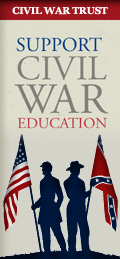|
Faces of Battle
By Charles R. Bowery
Humanities and Social Sciences Online (H-Net)
July, 2010
As we approach the Civil War sesquicentennial, it becomes increasingly difficult to visualize and understand the flesh-and-blood people who populated the legendary events that we study. Accordingly, the modern historian is truly lucky that the mid-nineteenth century also saw rapid developments in the art and science of photography. Civil War photographs offer a window into the human face of our national conflict. Ron Coddington’s Faces of the Confederacy is the latest work by this well-known historian of Civil War photography, and it provides just such a window. This book is a companion volume to an earlier work, also published by Johns Hopkins, that presents photographs of Union soldiers. Instead of generals and politicians, this collection also introduces the reader to the ordinary warriors — the privates, sergeants, and junior officers who filled the ranks of Confederate armies.
The seventy-seven images in Faces of the Confederacy are all surviving examples of the "carte de visite," a popular nineteenth-century form of mass-produced photography. Soldiers headed to the battlefront frequently sat for them, and emerging technologies allowed for a large number of prints at an affordable price. As the author notes, the Civil War took the lives of twenty-two of every one hundred soldiers involved, so these small photographic tokens were frequently the last real contact between a Union or Confederate soldier and his loved ones. In a useful foreward, historian Michael Fellman provides a brief overview of the history and development of the carte de visite, placing this technique into the context of Civil War photography at large.
With extensive research into the lives and military service of his subjects, the author adds an extra dimension of usefulness and quality to an already excellent collection of photographs. Coddington has mined manuscript collections, letters and diaries, unit histories, and period newspapers to resurrect a group of men who would otherwise be lost to history. Their experiences are by turns humorous, ironic, and heartbreaking, as only true stories can be, and they remind us that the pages of history are populated by real people, with all of the frailties, failings, nobility, and heroism that we see around us today.
Faces of the Confederacy is also a beautifully produced book, with high-quality, glossy paper that enhances the quality of the photographs. This excellent study will appeal to historians of Civil War photography as well as the enthusiast and genealogist, and it would also be a useful companion for a battlefield visit. Secondary school teachers discussing the Civil War would also find these photographs and stories to be a good method of connecting the war to the ordinary experiences of their students. Even at a distance of over a hundred years, the faces staring out of these pages create an undeniable emotional connection with the reader. This book is highly recommended.
|
|
